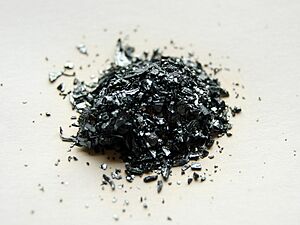Halide facts for kids
Halide is a special kind of chemical compound. It forms when an element from the Halogen group (like fluorine, chlorine, bromine, or iodine) combines with another element. Think of it like a team-up between a halogen and something else!
Contents
What are Halides?
Halides are compounds that contain a Halogen element and another element, usually a metal. Halogens are a group of elements on the Periodic table that are very reactive. This means they like to combine with other elements to form new substances.
When a halogen atom gains an electron, it becomes a negatively charged Ion called a halide ion. For example, a chlorine atom becomes a chloride ion. These halide ions then join with positively charged ions from other elements to create a halide compound.
Types of Halides
There are several types of halides, named after the halogen they contain. Each type has its own unique properties and uses.
Fluorides
Fluoride compounds contain the element Fluorine. They are well-known for helping to keep our teeth strong and prevent cavities. That's why you often find fluoride in toothpaste and some drinking water! Fluorides can also be found in minerals like Fluorite.
Chlorides
Chloride compounds contain the element Chlorine. The most famous chloride is Sodium chloride, which is common table salt! Salt is super important for our bodies and is used to flavor and preserve food. Chlorides are also found naturally in seawater and in our bodies, where they help with digestion and nerve signals.
Bromides
Bromide compounds contain the element Bromine. Bromides have been used in some medicines, especially in the past, to help with sleep or calm nerves. Today, they are often used as flame retardants in fabrics and plastics to make them less likely to catch fire.
Iodides
Iodide compounds contain the element Iodine. Iodine is very important for our health, especially for our thyroid gland, which helps control our body's growth and metabolism. Many countries add iodide to table salt (called iodized salt) to make sure people get enough of this important nutrient.
Astatides
Astatide compounds contain the element Astatine. Astatine is an extremely rare and radioactive element. This means it gives off energy that can be harmful. Because it's so rare and unstable, astatides are not found naturally in large amounts and are mostly studied in laboratories for scientific research.
Common Properties of Halides
Even though there are different types of halides, they share some common features:
- Often Salts: Many halides are considered salts. This means they are formed when an acid reacts with a base.
- Varied Forms: Halides can be found as solids (like table salt), liquids, or even gases, depending on the specific elements they are made from.
- Ionic Bonds: Most halides are formed through ionic bonds, where atoms transfer electrons to each other, creating positively and negatively charged ions that attract.
Where Do We Use Halides?
Halides are all around us and play many important roles:
- In Our Homes: From the salt on our food (sodium chloride) to the fluoride in our toothpaste.
- In Industry: Used in photography, water purification, and as flame retardants.
- In Nature: Found in minerals, seawater, and even in our own bodies, where they are essential for life.
See also
 In Spanish: Halogenuro para niños
In Spanish: Halogenuro para niños


